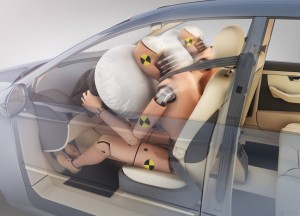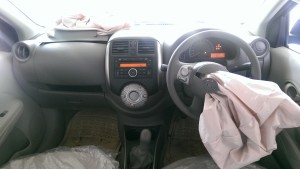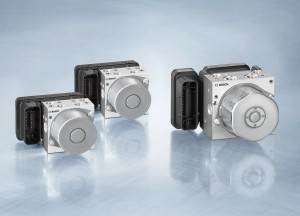The need for safety systems and related technologies have a new brief to care for, and it is termed as costs.
Text: Bhargav TS & Bhushan Mhapralkar
The definition of safety has been shifting throughout the life of auto industry world over and India is no exception to it. Concern for automotive safety despite the strong control of the government in the early years of the Indian auto industry did not diminish. A simple safety apparatus like seat belt arrived in India almost 3 decades after the Swedish automaker Saab introduced it as standard on its cars in 1958. The world’s first seat belt law was put in place in 1970, in the state of Victoria, Australia. It made it mandatory to wear the seat belt compulsorily for the driver and the front-seat passenger. Like the seat belt, the advent of newer safety-related technologies, both at the passive and active end, have been slow to arrive, and even slower to be made a standard offering in India. Many are driven by the enforcement of law much as it stems from the growing awareness in the minds of automotive buyers.
Retractable three-point seat-belts are given. The safety movement has moved to ABS and airbags. In two-wheelers and passenger cars, ABS is not yet mandatory, it has just been made mandatory in many classes of commercial vehicles from April 1, 2015. In case of buses, compliance with the Bus Body Code has been made mandatory. Both are looked upon as the right step ahead towards elevating automotive safety standards in the country. They have however also brought to the fore the issue of costs. It is no secret that India is a cost sensitive market, and the brief therefore is to meet the cost.
Inclusion of a technology however comes with an associated cost. The development of automotive safety systems may have grown leaps and bounds, with the easier availability to electronics and the associated software platforms. Costs however remain to be an important part of a development brief of a vehicle. And this is no longer limited to India, but also spreading to the other automotive markets around the world. Technology at cost is thus no longer a local phenomenon, it has gone global. India, as a matter of fact, leads with its ability to execute such tasks.
Engineers at the Mercedes-Benz Research and Development India design and model various sub-systems for Mercedes-Benz cars like the C-Class, E-Class and the S-Class. They also do it for Daimler trucks like the Canter, Axor, and the Actros, using CATIA V5. In touching areas like hydraulic piping, wiring harness, chassis design, powertrain, lighting systems, brake systems, suspension design, exhaust systems, fuel systems and interior development areas like seats and door panels, the engineers at the centre build finite element models of automotive subsystems and full vehicles (ANSA, Medina, HyperMesh, Primer) to carry out linear, nonlinear and dynamic analyses. These analyses are performed using tools like Nastran, Abaqus, LS-Dyna, Permas, Femfat, and Autoform. The engineers at the centre are also involved in different loops of virtual validation for various subsystems and contribute significantly to the improvement of design, cost and weight in vehicle safety areas like crash structure, Body-in-White (BiW), occupant safety, pedestrian protection; stiffness, strength, durability (chassis, BiW, components, complete vehicles); powertrain (NVH, strength, stiffness), NVH (BiW) and sheet metal forming.
General Motors’ R&D centre in Bangalore marked the establishment of such hub outside of US for the first time by the company in 2004. Set up to leverage the strong IT industry in India, and design and develop new systems and technology platforms in close co-operation with R&D hub at Detroit, at the core to invest in India was the need to keep the costs down. The Bangalore R&D is claimed to be working on many important technologies and platforms that will mark the future of the auto major in the future, and in markets including India and Asia. Erstwhile president and managing director of GM India, Karl Slym is known to have said in 2010 that the Bangalore R&D hub will lead GM’s worldwide development work on automatic transmission for small cars apart from working on the company’s entry into commercial vehicles segment.
The Fiat Chrysler APAC Tech Center at Chennai and Pune are known to conduct various design and development activities related to safety of the group’s products. In safety areas like compliance to ECE regulations, IIHS and Euro-NCAP safety regulations like whiplash assessment with an effort to keep the cost down, the 2 centre (Chennai & Pune) form the largest R&D divisions for Fiat globally and employ 1000 engineers who work with technical teams in Europe and Detroit on global platforms. Work involves seat programmes, instrument panels and vehicle body. All these have strong safety features, which are imperative. The engineers also undertake computer-aided engineering (CAE) simulation work on the group’s products, relating to crash, durability and noise vibration harshness (NVH) level analysis, on par with other standards. Erstwhile president and Managing Director of Fiat Chrysler Automobiles India is known to said that the centres also carry out development work with regard to electrical validation techniques, which includes hardware-in-the-loop and software-in-the-loop simulation.
At the tier supplier level, India is playing a crucial role in the development of safety systems and related products for vehicles on a global scale. A large chunk of Bosch’s engineering activities in India involve the developing of safety systems related software in areas calissified as testing and validation to new age technologies like telematics and infotainment and at costs that are promisingly less. While technologies like telematics and infotainment are considered as the path to connected cars that would be highly electronic in nature and reliant almost 100% on the intelligent software they contain (most of which would have been developed in India), Bosch is also known to carry out much development and research work in India in safety system areas like airbag, ABS, ESP and driver assistance system, navigation system, etc., for local as well as global application. In an interview to CV, Jacques Esculier, Chairman & CEO, Wabco Holdings Inc., said, “The software for the modular ‘Optidrive’ AMT was developed in India, and more than half of our total software developed are being carried out at Chennai.”
Apart from commercial vehicle braking systems, which play a crucial role in the safety of a commercial vehicles and the other road users in its vicinity, Wabco has also developed Automated Manual Transmission (AMT) modules apart from a collision mitigation system, lane departure warning system and a drowsiness warning system. Referring to the crucial role the company’s centre at Chennai is playing a role to adapt new technologies with lower cost. Esculier averred, “There’s not even a single new product that we develop in Germany, which is not reviewed by Indian.More than 30% of the Wabco are in India, which is a centre piece of the company’s entire strategy,” he added.
Considering the role the new infotainment systems in automobiles are set to play towards elevating the ability of vehicles to ‘connect’ with each other, and to communicate with the surrounding ecosystem, it may be worth considering the case of two cost-effective infortainmenet system platforms that were developed by the Harman International Tech centre at Bangalore. The centre is also doing much software and telematics related development for Harman markets around the globe, including its US home market. The two infotainment platforms – Sarus and Nalanda, implemented in low-cost autos that were found to be emerging in developing markets, were lapped up by two automakers in US immediately.
Safety laws in India may lag behind those that are found in the advanced markets overseas, the brief of developing safety systems with a brief, that they should fit the cost, be well honed as Indian engineers go about developing new safety technologies, softwares and platforms. It is perhaps their ability to develop safety systems at a lower cost that is ensuring that they have more exciting development activities coming their way. New clients are turning to India to address their need for safety systems that are in tune with the changing requirements of auto buyers since most of these are highly electronic and software-based in nature. An Indian startup, CariQ, for example, is working with many clients across the world, to make cars smarter. The Pune-based IoT (Internet of Things) startup has developed a Connected Car Platform, which works in deriving data from the microcomputer of the car and then posting it to the servers hosted on the cloud. This data is then analyzed and reports are generated on the car’s condition, driver credibility and much more.













Leave a Reply